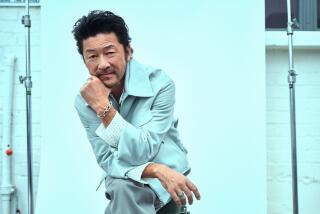Mifune Waxes Delight at Movieland Inclusion
- Share via
There has always been something mythical about Toshiro Mifune, Japan’s most famous star.
Since he burst upon the international scene 36 years ago in “Rashomon,” Mifune has been celebrated for larger-than-life portrayals--from fierce samurai and tycoons to saintly doctors and rickshaw men.
You’d think that Mifune, now 67 and considered one of the world’s greatest living actors, is due some sort of moviedom deification, even in America, where he remains Japan’s most durable screen export.
It may not be an Oscar, or even a star on Hollywood’s Walk of Fame, but Mifune has finally won entry to a pantheon that already includes such Hollywood icons as James Cagney, Gary Cooper, George C. Scott and John Wayne.
Today, Movieland Wax Museum in Buena Park is bestowing upon Mifune its ultimate accolade: his very own waxen clone, which the actor himself will unveil at 11:30 a.m.
And Mifune himself, the first Asian star to make the Movieland roster, seemed duly impressed.
“It is very well done, a very good likeness,” murmured Mifune on Wednesday when he first saw the figure--the warlord Toranaga he played in NBC-TV’s 1980 “Shogun” miniseries.
As Movieland general manager Ronald Fong tells it, there was never any doubt that the “Shogun” character would be used. Because of TV, Mifune’s Toranaga is vastly more familiar to U.S. audiences than Mifune’s more acclaimed roles in the Japanese films “Yojimbo,” “Throne of Blood” and “Record of a Living Being” .
The selection of Mifune is considered an extra attraction for Movieland’s large number of Japanese tourists, just as Mexican film idol Cantinflas was included in Movieland’s inaugural-year gallery in 1962 for his appeal to Southern California’s Latino population, Fong said.
Once Mifune agreed to the wax museum project in late 1986, the making of the figure moved quickly, Fong said. Measurements and photographs were taken in Tokyo early this year. The figure itself--from clay model to final wax filling--was completed by Movieland sculptor David Cellitti by the end of summer.
And Mifune, showing a personal interest rare for a Movieland subject, provided the wax museum with the silken garments, polished swords and other regalia for the “Shogun” setting.
Wednesday, the actor and his wife, Mika, arrived at the museum to take charge of the final task themselves, meticulously dressing the Toranaga figure down to the exact tying of sashes and placement of swords.
After 90 minutes, Mifune declared the figure ready, save for one detail. “The right eyebrow should be thicker--like this,” said Mifune, pointing to his own face. “Just a little more.”
When Cellitti painted a bushier eyebrow on the figure, Mifune looked relaxed for the first time. “Now . . . it’s OK,” he said with a broad grin.
Mifune was still in an expansive, widely gesturing mood at Knott’s Berry Farm, when he joined his wife and 5-year-old daughter for a fried-chicken lunch after dessing his wax replica.
Aided by his interpreter, actress Miiko Taka, he told stories about his 1950s encounters with some of Hollywood’s biggest stars.
Gary Cooper. Robert Mitchum. Burt Lancaster. Charlton Heston. Marlon Brando. “And Henry Fonda. He was a very good, very quiet but strong actor. Yes, I saw him in many Westerns, I believe the ones he made with John Ford.”
He particularly recalled the legendary “drinking capacity” of two American stars--John Wayne, who was in Japan shooting “The Barbarian and the Geisha” for John Huston, and Lee Marvin, Mifune’s co-star in the 1968 U.S.-made “Hell in the Pacific.”
He also reminisced about the movies he made during the boom years of Japan’s film industry in the 1950s and 1960s. Mifune then worked with some of the most celebrated directors in Japan, including Masaki Kobayashi, Kenji Mizoguchi and Hiroshi Inagaki.
But such memories invariably center on Mifune’s most famous benefactor, director Akira Kurosawa. After a 17-year collaboration that included “Seven Samurai” and “The Bad Sleep Well,” Mifune’s Kurosawa period ended abruptly with 1965’s “Red Beard.”
After years in the financial wilderness, Kurosawa still won enough foreign backers in the 1980s to make two more samurai-era epics, “Kagemusha” and “Ran” But the star of both much-praised films was Tatsuya Nakadai. Not Mifune.
And Mifune said the chances of a reunion with Kurosawa, now 77, are highly improbable.
The chief reason, Mifune maintains, is that Kurosawa’s projects have become increasingly costly and time consuming. “I have my own (producer) responsibilities,” said Mifune, who has headed a production company since the mid-1960s.
Mifune still occasionally makes films: His latest, an adaptation of the Japanese fairy tale, “Princess from the Moon,” is directed by the esteemed Kon Ichikawa.
But Mifune is busier with TV--now the dominant entertainment medium in Japan--and usually appears in adventure serials as a wandering, “Yojimbo”-like samurai-for-hire.
Ironically, the U.S.-made “Shogun,” which gave Mifune one of his best roles in years, was a TV blockbuster in the United States but a dud in Japan.
The reaction of Japanese audiences, Mifune suggested, was because of “historical inaccuracies” of the U.S. production (which was based on James Clavell’s best-selling novel).
But Mifune, ever the polite guest, chose not to elaborate on such cultural misinterpretations in “Shogun” or any other U.S. film about the Japanese--except to observe, rather tersely: “Sometimes they (Americans) take too many artistic liberties.”
More to Read
The biggest entertainment stories
Get our big stories about Hollywood, film, television, music, arts, culture and more right in your inbox as soon as they publish.
You may occasionally receive promotional content from the Los Angeles Times.










